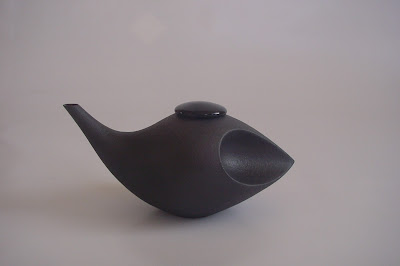KM: You trained in England and have, since arriving here in 1973, exhibited extensively here and overseas and have featured in many publications.
Given your extensive experience as a pottery tutor, having taught since 1981 – what do you look forward to with the upcoming course at Corban Estate Art Centre?
RR: I really enjoy the concentration necessary of shorter courses, the level of focus required, the adrenalin... I want the students to milk me for as much information as possible...In fact, I'll know I haven't done a good job if I'm not drained at the end of the course!
KM: What do you enjoy most about teaching others?
RR: It is very satisfying engaging with different personalities and adapting to different needs at each course. Are they novice or experienced? It doesn't matter. The challenge of each situation keeps tutoring fresh for me as each atmosphere is new and I therefore demonstrate in a different way.
KM: Do you gain perspective on your own work while teaching?
RR: While I like working on my own, you always gain ideas during workshops – they can really spark things off for me.
KM: Over the course of 5 days, you'll be teaching students your techniques of pinching and coiling. What will the students gain from these methods?
RR: Any shape is possible with this process – you can have very rounded forms to the very angular; they can look 'thrown' or look 'slab built'. A great advantage is that the forms don't have structural weaknesses – and that the method allows large scale objects to be made – building up from the bottom.
KM: I understand that as a young student, you discovered your facility with clay despite being enrolled on a textiles course?
RR: I discovered I don't think in 2D during my Textiles course...After 2 or 3 months I went downstairs to the pottery class one evening and worked with clay for the first time. I finally twigged. 'Clay was the Way'. Therefore, while I had hated life drawing, I later loved making torsos out of clay.
Later when working with clay, I resorted to doing 'working' drawings after the objects were done – which was probably obvious to the tutors!
KM: Were there other moments or experiences that helped you along the way?
RR: I developed an appreciation for the Oriental aesthetic. However, it took two trips in 1995 and 1997 to Japan for the penny to really drop. I marvelled at the pottery tradition in Japan and Japanese aesthetic, ...their talents and importance.
In fact I have a large collection of Japanese drinking vessels - I loaned them to Objectspace recently – 100 works collected over several years.
KM: Were there individual practitioners who inspired you along the way?
RR: There were two strands of influence for me – the Modernist was one - Lucie Rie, a Viennese potter who left Nazi Germany to live in London, and Hans Coper who she mentored and then worked alongside, were my gods. Function informed the shapes, but the resulting object was very much an aesthetic object. The sculpture of Henry Moore and Barbara Hepworth was also very formative. I went down to London to a wonderful Henry Moore exhibition when I was still living in England.
The other strand was represented by the domesticware of important British studio potter Bernard Leach who launched an Anglo/Japanese tradition with Japanese potter Hamada.
Rustic simplicity was key.
KM: And now?
RR: I've been around so long, it's now a matter of my own work influencing me. I go back and forwards – returning to ideas and re-developing forms in different directions.
KM: Does function play much of a role as opposed to aesthetic considerations in your work?
RR: The teapot, for example, is an easy entry point for people. They know what a teapot is. A teapot of mine doesn't pour and well, it's impossible to get a teabag in... For me, it's all about form.
KM: Your works that I saw recently are suggestively figurative, lively and playful – what are some of your visual stimuli?
RR: People see all sorts of things in my work. It's just a form but that's ok. People even see mountains... I never put titles on my pieces. The shapes, line and form are suggestive of anthroporphism at times.
KM: What are your thoughts on pottery today?
RR: There are fewer full-time potters. Many of the existing potters went off and got 'real jobs' when cheap imports came in in the 1980s. The 70's was the heyday – anyone could make pottery and sell it. Now there is a discerning public and that's good. It's healthy not to have an oversupply and more important to get quality.
Now you get more part-time potters – who I would not call hobbyists – they are often just as professional as the full-time potters.
KM: Why do you prefer to be called a studio potter rather than ceramicist?
RR: In the 1980s, you could go and do 'hobby ceramics' – and someone else would fire your pieces. It was somewhat 'by numbers'. To me, 'ceramicist', still smacks of that scenario.
The 'studio potter' makes one-off pieces so I use that description.
KM: What are your thoughts on the status of New Zealand pottery/ceramics?
RR: I think we punch above our weight, given our population size. These days influence and ideas can go round the world in 5 seconds with the internet. We're not so isolated any more.
It never worries me when people copy or take ideas from my work. Everyone's got to start somewhere in order to move onto something else...























